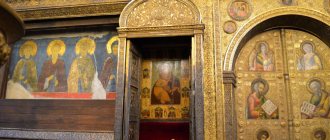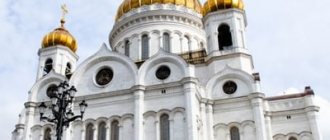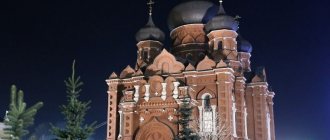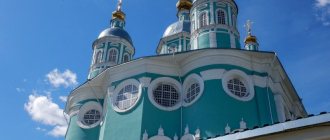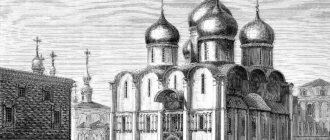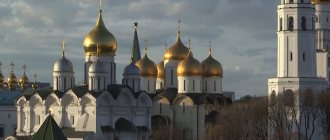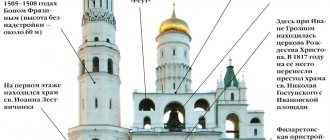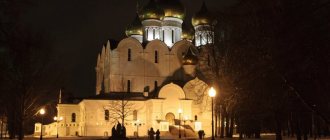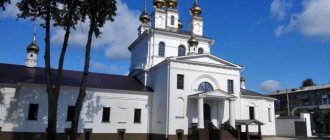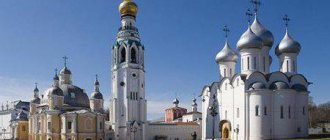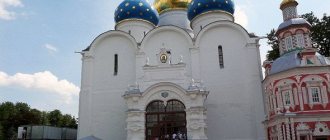Cathedrals and churches of the Moscow Kremlin
Ancient Moscow Kremlin. Last time you and I walked through its territory, looked at its famous sights - the Tsar Cannon and the Tsar Bell, and looked at the ancient cathedrals and churches. Today I would like to invite you to look inside some of them and learn a little more about the history of these ancient places of worship.
Panorama of the Moscow Kremlin from the Patriarchal Bridge
A tour of the Cathedral Square ensemble includes entrance to the museum territory and a visit to the Assumption, Annunciation and Archangel Cathedrals, the Patriarchal Chambers, and the Church of the Deposition of Robes. The Ivan the Great Bell Tower was closed on the day of my walk.
Unfortunately, it will be impossible to visit the Moscow Kremlin museums in the near future. they are closed until January 15, 2021.
It must be said that when I asked whether it was possible to take photos inside the temples, the employees answered that they were already allowed. Apparently, there used to be a ban on photography here, but today you can take pictures without a flash in every room. So don't forget to take your camera with you. So, a little about each of the temples I visited.
Assumption Cathedral
The Assumption Cathedral is one of the most significant and famous religious buildings of the Moscow Kremlin. Over the centuries, under the arches of the ancient temple, emperors were crowned kings, great princes were installed, metropolitans and patriarchs were elected, enthroned, and buried. Now in the Assumption Cathedral there are 19 burial places of Russian saints.
Assumption Cathedral
The iconostasis of the cathedral was created in 1653
The cathedral building was built by the Italian architect Aristotle Fioravanti in 1475–79. The prototype of the Moscow temple was the Assumption Cathedral in Vladimir.
The cathedral was closed for worship in 1918; since 1955, the building has been open to visitors again, albeit as a museum. Divine services within the walls of the temple resumed at the end of the 20th century.
More than 200 subject compositions and about 2,000 figures were used in the design of the cathedral.
mural painting
Patriarchal Chambers and Church of the Cathedral of the Twelve Apostles
The building of the Patriarchal Chambers was erected on the site of more ancient buildings in 1652–1656, and the finishing of the premises continued over the next two years. The first floor of the building was used for household needs, the second was reserved for state rooms, and the third housed the patriarch's living quarters.
House Church of the Cathedral of the Twelve Apostles
Front Cross Chamber
Among the ceremonial halls of the Patriarchal Chambers, one can highlight the huge Cross Chamber. For the first time in the history of Russian architecture, a room with an area of 280 square meters was covered with a single vault, without any supports. On ordinary days, the chamber served the patriarch as a reception room; on special occasions, various church events, receptions and meals were held here.
Marble oven for cooking the world
In this part of the museum, the interior of a rich Moscow house of the 17th century is recreated
After the revolution, the building was transferred to the museum; in 1967, an exhibition on the second floor was opened. Today the exhibition is called the Museum of Applied Art and Life of Russia of the 17th Century.
Church of the Deposition of the Robe
West of the Assumption Cathedral there is a small Church of the Deposition of the Robe of the Blessed Virgin Mary, or the Church of the Deposition of the Robe. The building was built on the site of an older temple in the 1480s as the home church of the metropolitans and patriarchs. The name of the building refers us to the Byzantine holiday of the Placing of the Robe of the Blessed Virgin Mary.
Church of the Deposition of the Robe. Entrance
Dome and vaults
Iconostasis
Nowadays, the exhibition “Russian wooden sculpture of the 15th – 19th centuries” is located here.
Cathedral of the Archangel
The next building of the Cathedral Square ensemble that we will visit is the Archangel Cathedral, dedicated to the Archangel Michael. The building was the tomb of the Great Moscow and appanage princes. The last burial dates back to 1730; the fourteen-year-old Russian Emperor, Peter II, was buried here.
Cathedral of the Archangel
Composition “Fatherland”
In the necropolis of the cathedral lie many other famous historical figures: Ivan I Danilovich Kalita, Dmitry Ivanovich Donskoy, Ivan IV Vasilyevich the Terrible, the first tsar of the Romanov dynasty, Mikhail Fedorovich.
Royal Doors
The iconostasis consists of four tiers
The building of the Archangel Cathedral was erected in 1505–08 by the Italian architect Aleviz Fryazin (Novy). The master should not be confused with another Aleviz, called the Old. The famous Alevizov ditch on Red Square was named after the latter.
Blagoveshchensky cathedral
The last cathedral for today is the Annunciation Cathedral. Its building was built in 1484-89 on the site of a white stone temple of the 14th century that existed here. The construction was carried out by an artel of Pskov craftsmen.
Blagoveshchensky cathedral
Portal
The interior of the temple was destroyed by fire in the middle of the 16th century; subsequently the murals were restored. Under Ivan the Terrible, the cathedral was significantly rebuilt; it became nine-domed. From 1918 to 1993, no services were held in the temple.
Architectural exhibition on the southern gallery
Painting of the dome and vaults
Here our short walk through the cathedrals of the Moscow Kremlin comes to an end. I hope the article helped you learn something new about these interesting ancient monuments. I, as a resident of St. Petersburg, cannot help but leave here a link to one of the most famous churches of the Northern capital, the famous St. Isaac's Cathedral.
In short, in general:
- beautiful ancient temples;
- in each cathedral you can find information materials telling about the history of the building;
- The visit is combined with a walk around the Kremlin territory.
Frescoes of the Annunciation Cathedral
The cathedral was painted in 1508. This date is considered the end of the work on creating frescoes on the walls.
The main place in terms of volume and significance on the frescoes of the cathedral is devoted to illustrations from the Gospel, combined into several cycles - holidays, passions, miracles and parables, the appearance of Christ after the resurrection.
In the central part of the cathedral there are frescoes with scenes from the Apocalypse. “The Last Judgment”, “Procession of the Righteous Next to the Gates of Paradise” and many other subjects are reflected in the paintings of that time.
Fresco from the Apocalypse cycle. “The procession of the righteous, following to the gates of heaven”, © Official website of the Annunciation Cathedral in the Kremlin
In the side parts of the cathedral, “Princely” themes alternate (images of great princes canonized as Saints) and images of theophanies - visions of God. A special group includes the paintings of the choirs, where chapels were once located.
In the Annunciation Cathedral, the depiction of holidays - the main events in the life of Christ - is given a central place. These compositions are combined into several groups. The most significant of them: “Annunciation”, “Nativity of Christ”, “Journey to Bethlehem”, “Flight into Egypt”, “Massacre of the Innocents”, etc.
In the western part of the cathedral there are frescoes telling about the divine essence of Christ. Among them: “Candlemas”, “Baptism”, “Resurrection of Lazarus” and “Entry into Jerusalem”. The main vault and its southern part are filled with illustrations of Christ's miracles and healings, as well as biblical parables.
Fresco “Transfiguration of Christ”, © Official website of the Annunciation Cathedral in the Kremlin
Architecture
The appearance of the Assumption Cathedral is surprising in its difference from the cross-domed model traditional for Russian and Byzantine churches. In the usual version, one could observe a combination of parts of the building of different volumes. The façade of the Assumption Cathedral consists of spindles of identical width and height, ending with arched arcs, which gives rise to a feeling of solidity.
At the level of the windows of the lower tier there is a “belt” of the building - an architectural columnar frieze. Unlike other churches, it is not so voluminous and expressive and perfectly complements the restrained style of the cathedral.
There is an asymmetry in the composition, which is easy to see if you look at the temple from the southern facade. The heads of the cathedral, as well as the southern and northern gates, are shifted towards the east. At the same time, the apses located on the eastern side are not as voluminous as in the Byzantine tradition, and are covered with pylons. All together enhances the impression of massiveness, solidity, and unity.
© Maria Penina
Icons
The main iconostasis is located opposite the western gate. The ensemble, consisting of 69 icons, was created in 1653 by several artists from Kostroma and Yaroslavl in just 10 months. Structured in 5 rows. The upper, forefathers' row includes not only a full-length image of the forefathers with scrolls, but also an icon of the Holy Trinity. The prophetic level consists of 17 images. The festive row is filled with icons depicting the main events of the New Testament. The Deesis series includes images of the apostles, an icon with the prayer of the saints at the Last Judgment, and an icon of the “Savior Almighty.” In the bottom row are “The Golden Robe of Savior” and “The Ardent Eye of Savior.”
The most ancient icons are located near the southern wall, including “Metropolitan Peter with his Life.” It is believed that it was written by Dionysius, a follower of Andrei Rublev. The iconostasis near the northern wall contains icons by the servants of the Solovetsky Monastery. They were brought in 1923. The most famous images are “It is Worthy to Eat” and “The Mother of God of Bogolyubsk, with the Lives of Zosima and Savvaty of Solovetsky.”
